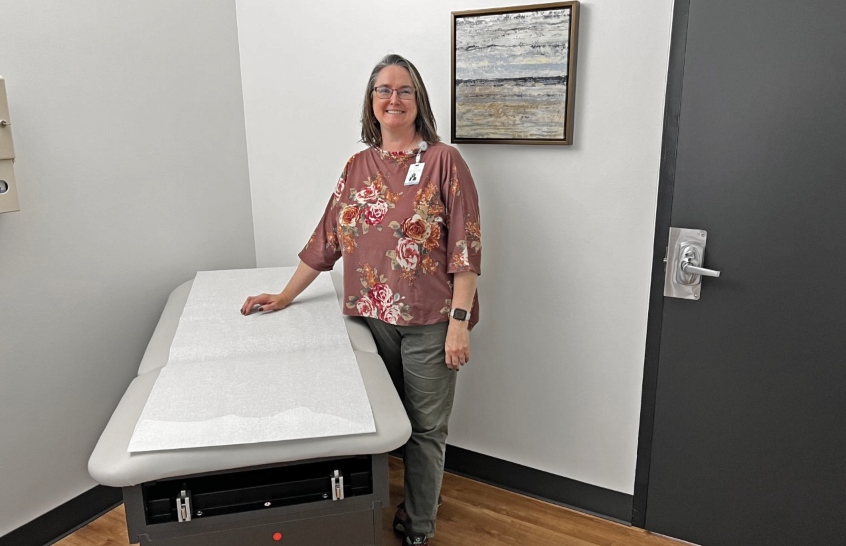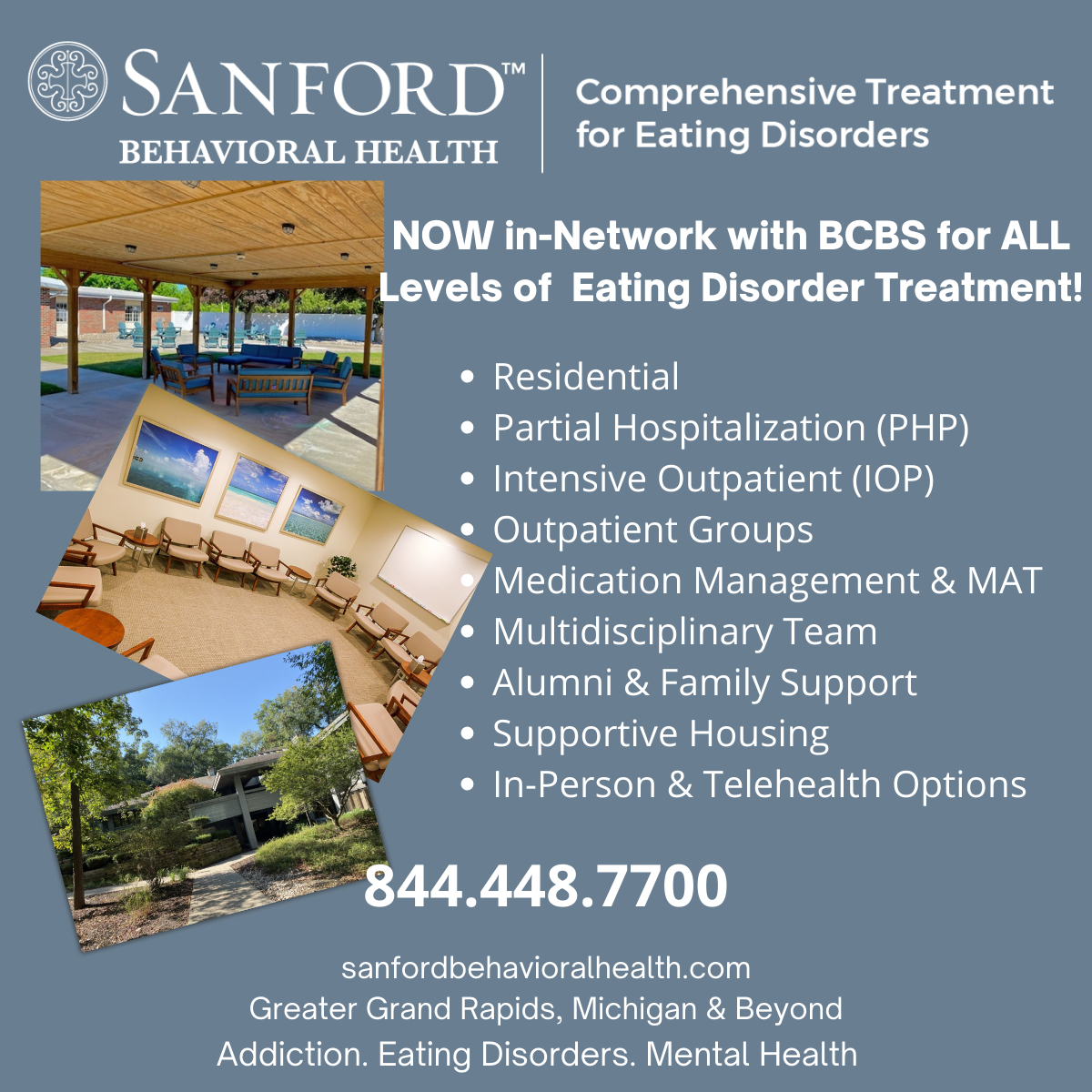The Effects of Eating Disorders on the Whole Body – Limelight Interview

The Nurse Practitioner will see you now.
At Sanford Behavioral Health, we are proud of the team we have assembled, with some of the brightest minds in the behavioral health field. At Sanford Comprehensive Treatment for Eating Disorders (SCTED), the interdisciplinary team works to treat the whole person. According to our Limelight interviewee, Amy Boshoven, her “welcoming” teammates have an open-door policy when it comes to their patients. We sat down with Amy, who holds two master’s degrees in nursing and certification in two nurse practitioner fields, to discuss integrative programming dynamics at Sanford. We also discuss the effects of eating disorders and a term she says she should trademark – crunchy brain syndrome.
Limelight Interview Amy Boshoven, MSN, WNHP-BC, PMHNP-BC, CEDS
The Effects of Eating Disorders on the Body

The friendly face of Amy Boshoven – demonstrating crunchy brain syndrome via telehealth.
Sanford – How did you come to Sanford Comprehensive Treatment for Eating Disorders (SCTED)?
AB – Let me start back at the beginning. I began my career as a women’s health practitioner and did reproductive medicine for twelve years. It seemed I had accomplished everything my organization could let me do, and I felt stuck. I decided to do something different, something out of my comfort zone. I began working in an inpatient psych facility and really enjoyed it. This led me to return for a post-masters in Psychiatric Mental Health NP. I worked in inpatient psych for fourteen years. Then, as it turns out, the Nurse Practitioner working with Dr. Masterson at Sanford was leaving. Dr, Masterson was the original psychiatrist I trained with, and I took a leap of faith to join the team working with eating disorders.
Working with those in the residential eating disorders program has allowed me to use some of the old skills I have not used since my reproductive medicine days. I am frequently working with women of reproductive age. And I also manage any other medical and psychiatric complications that come up. With Partial Hospitalization Programs (PHP day programming), these folks are further along on their journey and typically healthier. As a result, I primarily take care of their psychiatric needs, such as depression, anxiety, and OCD. They see their primary care providers for other health needs.

SCTED residential bedroom and clinical kitchen.
Sanford – What are the unique aspects of residential treatment?
AB – When I see patients in residential treatment, I look at the whole body. What medical complications did this person have due to their eating disorder? And what problems have arisen now that the person is feeding themself? Temporary discomforts like bloating and sluggishness will happen; it gets worse before it gets better.
Sanford – Your role is medical, correct?
AB – Correct. I have two master’s degrees in nursing and certification in two nurse practitioner fields. I do psychiatric evaluations, identification of their mental health needs, and start patients on medications for things like depression and anxiety. And because I have training in women’s health, I also have the skill set to manage their health needs, like primary care. I also screen for high blood pressure, cholesterol, etc.
Sanford – Please talk about the interdisciplinary team you work with at SCTED.
AB – I do not do therapy. I tattle on myself if I do anything therapeutic because I like to stay in my lane. Working as an interdisciplinary team is so crucial! I defer our patients to their therapy and dietary components of treatment. We all work together for a common cause; I am just one link in the chain. We have an interdisciplinary team meeting once a week. This is an open dialogue between a client’s entire treatment team. We view our clients holistically; each discipline is vitally important to client care. Our offices are across the hall, so I can pop into a therapist’s office if I have something on my mind and vice versa.
Our patients’ daily life includes group therapy with licensed therapists, activity therapists, art therapists, and dietitians. Group facilitators have a wide range of topics, including skill-building or process groups. They also meet with their therapist one-on-one and dietitian for nutrition assessments. I see them three times a week – with this acuity level, it is necessary. However, I am also available more than that when needed. During the day, they might be cooking or doing movement/art/experiential activities, and I call them out individually to check on sleep, energy, and eating patterns. I also look for complications like bloating and fullness after meals, which arise when reintroducing food.
Sanford – What is the key to successful outcomes?
AB – Having a good treatment team is essential. Eating disorders do not occur by themselves. It’s a disease of secrecy, much like substance use disorders. To succeed, you must ask, “What is the eating disorder doing for you?” Is it managing depression and anxiety? Is it the result of an adverse childhood or trauma? Maybe you have a texture or smell that prevents you from eating certain foods. And after treatment, it is vital to have a sound support system. The most successful people I have seen keep up with their therapeutic, nutritional, and psychiatric needs. At Sanford, we ensure those components and resources are in place before a client leaves treatment. And with telehealth, we can keep in contact long-term.
Sanford – What is the role of the family in eating disorder treatment?
AB – Families are greatly important. Many of our clients are going home to their mom and dad or a spouse, and they must understand what is happening with their loved ones. Therefore, we provide family therapy at SCTED and have referral sources for ongoing family therapy. In addition, we incorporate Emotionally Focused Family Therapy (EFFT) that addresses education, support, and skills for success for the whole family. Sanford’s clients also learn to set boundaries and rehearse potentially challenging scenarios through role-playing. Diet culture is so prevalent in our world that we help clients navigate the minefields by removing triggering APPs and setting ground rules at home.
Sanford – What are the medical effects of eating disorders?
AB – How much time do you have? (Laughs) Unfortunately, every body system is impacted by an eating disorder. I refer to it as crunchy brain syndrome. Your brain is a nice, big sponge. As you restrict calories, the dryer, and dryer the brain gets. You are reverting to caveman mode, where your body is trying to survive. In other words, your brain does not know you are choosing to restrict food; it sees famine. It is in a chronic flight or fight mode where the body conserves calories as efficiently as possible. The brain gets dry and hard like an old sponge. As the brain dries and loses elasticity, body functions shut down. It is difficult to learn or focus, your sleep is off, and you have depression and anxiety. And the brain, which uses 20% of the calories consumed to function, does not have the calories it needs.
Eating disorders impact the kidneys, lungs, heart, and bone marrow density. Dry skin, brittle hair, hearing loss, ringing ears, and sunken eyes result from fat loss and malnutrition. I try not to bombard our patients with information but give a little at a time. They do feel sluggish at first; their systems have not had to work efficiently for a time. For those who abuse laxatives, their GI system doesn’t work well. It has been artificially functioning, and the body needs to relearn how to work on its own.
I can prescribe medications to relieve the symptoms, but the primary medication is food. (The patients roll their eyes when I say this, but it is a fact.)
When it comes to binge eating disorders, you worry about cardiovascular disease and diabetes. Purging has its own symptoms. When you induce yourself to throw up, hydrochloric acid in the stomach comes up through the mouth. As a result, there are dental problems, mouth sores, neck and salivary glands swelling, and broken blood vessels in the eyes. You can also have a tear in the esophagus, a life-threatening surgical emergency. Purging affects phosphorus levels which causes shortness of breath and swelling. Purging with stimulant laxatives can shut down your entire GI system and cause kidney and heart problems,
Sanford – Let’s conclude with the positives – what is the good news?
AB – First, anyone can have an eating disorder. Your color, shape, size, religion, or socio-economic background does not matter. 96% of those with eating disorders have what would be considered “normal” or over-normal weight. So, the stereotype of the anorexic as a person with an eating disorder is a fallacy. Looks are deceiving. And the body is so resilient; even with a crunchy brain, your labs can be normal for a very long time.
Second, if you have concerns, please don’t hesitate to ask for professional help. The sooner, the better. There is no shame in asking for help for yourself or a loved one. Open the dialogue and ask, “Are you okay?” Listen to the answer. Lastly, think before you say, “You look great; have you lost weight?” It is much better to say, “I’m glad you are here,” or “You are good at bringing people together.” Changing the diet culture starts with conscious effort.
Thank you, Amy!




